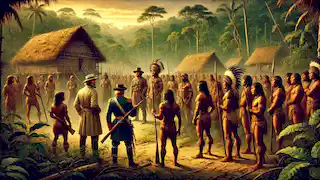The Story of the Shuar Tsantsa (Shrunken Heads)
Reading time: 8 min

About this story: The Story of the Shuar Tsantsa (Shrunken Heads) is a Historical Fiction from Ecuador set in the 19th Century This Descriptive tale explores themes of Courage and is suitable for Adults. It offers Cultural insights. A journey into the sacred rituals of the Shuar and the mystery of Tsantsas in the Amazon.
High in the dense, humid rainforests of the Ecuadorian Amazon, the ancient tribe of the Shuar dwelled, surrounded by a world teeming with life and secrets. The Shuar people, known for their intimate relationship with nature, were deeply spiritual, their beliefs deeply rooted in their connection with the jungle. Of all their practices, none captured the imagination of the world quite like the creation of Tsantsas — shrunken heads. A mysterious and sacred process, the crafting of these heads was intertwined with their beliefs about power, revenge, and the afterlife. This is the story of the Shuar Tsantsa, a ritual that has intrigued and horrified outsiders for centuries.
The Warriors of the Shuar
In the shadowed valleys of the Andean foothills, the Shuar lived in scattered villages, each community a stronghold of fierce warriors. The forest, dense and dark, was their protector, their home, and their provider. The Shuar were not only hunters and gatherers but also protectors of their way of life, fighting to defend their land from outsiders and rival tribes. Their understanding of the jungle and their expertise in guerrilla warfare made them formidable adversaries.
The Shuar warriors believed in a world where the spiritual and physical realms were intertwined. Spirits roamed the forest, guiding them, watching over them. To protect their communities and honor their ancestors, they performed intricate rituals, and at the heart of many of these rituals was the Tsantsa. A Tsantsa was more than just a trophy; it was the culmination of a spiritual conquest. The process of creating it held profound meaning, signifying the domination of an enemy's spirit.

The Sacred War Path
The path to creating a Tsantsa began with war. For the Shuar, warfare was not just about land or resources; it was a spiritual mission. They believed that the soul, or *arutam*, of a slain enemy could seek vengeance from the afterlife if it were not properly contained. This vengeance could bring misfortune, illness, or death to the living. The solution was to prevent the enemy's spirit from escaping and attacking the living. This belief fueled the practice of creating Tsantsas, as shrinking the head of a defeated warrior was a way to trap the vengeful spirit inside.
When a warrior from the Shuar set out on a raiding party, he did so with the intent of not only claiming victory but also capturing the *muisak*, the spirit of his enemy. They believed that by shrinking the head and sealing the eyes and mouth, they could imprison the spirit and neutralize its power. This was essential in ensuring peace for the Shuar community and demonstrating the warrior's dominance.
The Art of Shrunken Heads
The process of creating a Tsantsa was both complex and sacred. Once a Shuar warrior had slain his enemy, the process began immediately. He would sever the head from the body, a task done with respect and reverence, for this was not a mere trophy, but a vessel of spiritual power. The head was taken back to the village, where the intricate ritual of shrinking it would take place.
First, the skin and hair were carefully removed from the skull, leaving behind an empty shell. The skull itself was discarded, as it was not needed for the final product. The skin was then treated with a mixture of herbs and plants, known only to the Shuar, that helped to preserve it. The next step involved boiling the skin in water, a process that would cause it to shrink while retaining its distinct human features. The head would then be dried using hot stones and sand, which further contracted it to a fraction of its original size.
The final stage of the process was perhaps the most crucial. The eyes and mouth of the Tsantsa were sewn shut, symbolically sealing the spirit inside. The skin was then blackened with smoke, giving the Tsantsa its signature dark hue. Once completed, the shrunken head would be displayed in the warrior's home or given as a sacred offering to the community. It was a powerful reminder of the warrior's victory and a symbol of protection for the village.
The Power of the Tsantsa
For the Shuar, the Tsantsa was more than just a symbol of victory; it was a potent talisman that conferred protection and power. The Shuar believed that the head of a fallen enemy held his spirit and that by shrinking it, they could trap that spirit and prevent it from seeking revenge. This act of control over the spirit world was of utmost importance, as it allowed the Shuar to maintain balance in their community and avoid the wrath of angry spirits.
The Tsantsa was also believed to transfer the power of the fallen enemy to the victor. By possessing the Tsantsa, the Shuar warrior was thought to gain the strength and courage of the one he had defeated. This belief made the creation and display of the Tsantsa a source of great pride among the Shuar people, as it demonstrated the warrior's bravery and prowess in battle.

European Encounters
The outside world first learned of the Shuar and their practice of shrinking heads in the mid-19th century, when European explorers and missionaries ventured into the remote regions of the Amazon. Fascinated and horrified by what they saw, these outsiders brought stories of the Shuar and their Tsantsas back to Europe, where they became the subject of much speculation and intrigue. To Westerners, the practice of shrinking heads seemed barbaric and alien, yet they could not deny the craftsmanship and precision involved in the creation of a Tsantsa.
As demand for these exotic curiosities grew in Europe and North America, the Shuar were drawn into a dark period of exploitation. Traders began offering weapons and goods in exchange for Tsantsas, leading to an increase in raids and violence among the Shuar and neighboring tribes. What was once a sacred and spiritual practice became commercialized, with Tsantsas being produced specifically for trade rather than ritualistic purposes. This period of exploitation brought significant changes to the Shuar way of life and threatened the survival of their traditions.
The Decline of the Tsantsa Tradition
By the early 20th century, the trade in Tsantsas had reached its peak. Museums and private collectors around the world sought to acquire these rare artifacts, often paying large sums of money to do so. However, the commercialization of the Tsantsa had devastating effects on the Shuar culture. The once-sacred ritual of head shrinking became corrupted, as warriors began to create Tsantsas purely for profit rather than for spiritual reasons.
The increasing violence and demand for heads led to conflict not only between tribes but also within Shuar communities themselves. The traditional reasons for headhunting — defense of the tribe and spiritual balance — were overshadowed by the pursuit of wealth. Recognizing the harm that this was causing to their society, the Shuar began to turn away from the practice, and by the mid-20th century, the creation of Tsantsas had all but disappeared.

The Shuar Today
Today, the Shuar people continue to live in the Amazon rainforest, though their way of life has changed significantly over the past century. The influence of modern technology, education, and outside contact has brought both challenges and opportunities to the Shuar. Despite these changes, they have worked hard to preserve their culture and traditions, passing down their knowledge of the jungle and their spiritual beliefs from one generation to the next.
While the practice of shrinking heads is no longer a part of Shuar life, the Tsantsa remains an important symbol of their cultural heritage. Museums around the world now house Tsantsas, serving as reminders of the Shuar's fierce warrior spirit and their deep connection to the spiritual world. For the Shuar people, these artifacts are a testament to their ancestors' bravery and a reminder of the importance of balance between the physical and spiritual realms.
Legacy and Myth
The legacy of the Tsantsa continues to captivate people around the world. Popular culture, from movies to books, has taken inspiration from the Shuar practice of shrinking heads, often sensationalizing or distorting its meaning. To many, the Tsantsa is a symbol of mystery and the unknown, a relic of a time when the world was still full of untamed wilderness and ancient rituals.
However, for the Shuar, the Tsantsa is much more than a curiosity or a trophy. It represents a profound understanding of the relationship between life and death, power and spirit. The Shuar believed that the world was full of spirits, both benevolent and malevolent, and that it was the duty of the living to maintain harmony between these forces. The Tsantsa was one way in which they sought to achieve this balance, trapping the dangerous spirit of an enemy and ensuring the safety of the living.

Conclusion
The story of the Shuar Tsantsa is one of spirituality, survival, and transformation. The creation of a Tsantsa was a deeply meaningful ritual that allowed the Shuar to assert control over their world, both physical and spiritual. While the practice of shrinking heads may have faded into history, the values and beliefs that it represented continue to live on in the hearts of the Shuar people. As we look back on this tradition, we are reminded of the complexity of human culture and the many ways in which different societies understand life, death, and the mysteries that lie beyond.


















